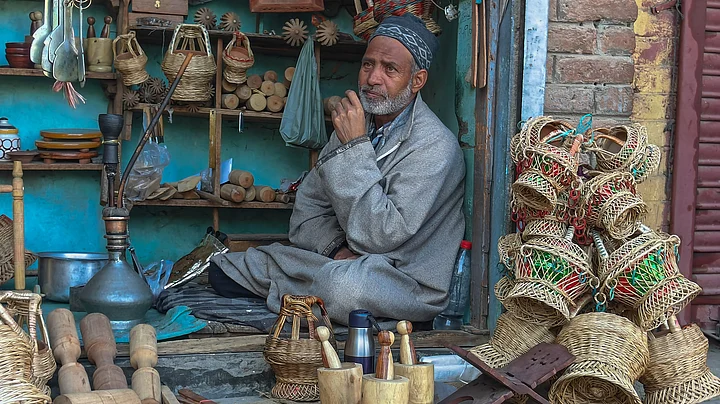Inside a workshop filled with the scent of clay, 35-year-old artisan Mohd Ayoub Dar from Charar-e-Sharief in Jammu and Kashmir's Budgam district skillfully weaves intricate patterns into a kangri, a traditional earthen pot wrapped in wickerwork.
His time-worn hands move rhythmically, displaying Dar's decades-long skill and understanding of the cultural significance of each kangri.
The age-old vessel is known for creating warmth for the local community in harsh winters. At the same time, it symbolises resilience and the locals' intangible connection with their inherited legacy.
But, talking about World Kangri Day, celebrated on 19 February every year, Dar expresses disappointment and anger.
"What Kangri Day! Nobody pays heed to us. Only social media influencers are praised, but traditional kangri-makers are ignored," Mohd Ayoub said, emphasising that making kangri is a way of life, and not a craft, for him and many others like him.
Over the years, he alleges, the presence of influencers has threatened traditional Kangri production, promoting replica Kangris as aesthetic accessories, featuring vibrant colours and elaborate designs that appeal to a wider market outside Kashmir, and reducing the demand for the traditional kangri.
Tracing The Origin of Kangri in Kashmir
The kangri, a traditional warming tool, predates the Mughal empire in Kashmir. Historians suggest that it was introduced to Kashmiris by Italians during the Mughal era (1526-1757), but the claim lacks concrete evidence.
Historical records show kangris were in use even before 1526, closely associated with Saint Sufi Sheik Noor-u-din Wali (1377-1440), who was buried with his beloved Charari Kangri, one of his most priceless belongings.
Ali Mohd Dar, a kangri-maker from Charar-e-Sharif, who was recognised as the best kangri-maker in the valley in 2022, told The Quint, "Crafting the kangri is a legacy passed down through generations. The Charar Kangri is particularly remarkable, bearing the name of Sufi saint Sheikh Noor ud Din. It is considered a remnant from the Sheikh's lands."
Sir Walter Lawrence, author of The Valley of Kashmir, concurs with Ali Mohd, stating that "the pretty painted kanger is among the most prized of the Charari Sharif fairings."
From Harvest to Handcraft: The Kangri Making Process
Crafting kangris is a traditional Kashmiri practice showcasing the region's rich cultural heritage. Ghulam Nabi Ganai, a kangri artisan from Ajas in Bandipora district, famous for its kangri, describes the process:
“Making a kangri requires effort, local craftsmanship, and specialised knowledge. After harvesting from deciduous plants, the process involves preparing twigs by scraping, peeling, boiling, and drying them before expertly weaving them into an earthen bowl, a wicker basket with handles, and a sturdy base."
The final product, adorned with colourful threads, mirror work, and sequins, symbolises eco-friendly and cost-effective indigenous craftsmanship.
However, traditional kangri is also staring at the decline in Parrotiopsis shrubs, affecting twig availability.
“We used to gather materials from the wild, but due to the shrub shortage, we now have to buy willow, which is expensive," says Ghulam Nabi.
The Parrotiopsis shrub, the primary twig, has become shorter, and the seed must pass through hangul (Kashmir stag) and black bear digestive systems.
Intesar Suhail, Wildlife Warden of North Kashmir, said, “The acid in hangul's stomach dissolves the seed's outer coat, facilitating germination. The decrease in the population of hangul has impacted seed regeneration. Nowadays, Pohu Hatab (Parrotiopsis) growers repopulate through budding. Availability has also decreased due to increasing use in shovel, axe, and spade handles.”
"However, it has been observed that, as it is not used for kangri or other crafts, this shrub is seen growing again in many areas," he added.
How Kangri Makers are Facing Economic Decline
The diminishing appreciation for authentic kangri poses economic challenges, and also threatens Kashmir’s cultural heritage. Moreover, since it is traditionally used as a heating device during harsh winters, kangri production has suffered due to climate change and delayed snowfall, causing a steep decline in demand.
Artisan Ghulam Nabi, lamenting the impact of climate change on production, said, "Before this year, I used to make at least 600-700 kangris. However, climate change has led to a decrease, with only 200 kangris made this year, affecting not just kangri-makers but also artisans and those dependent on this craft."
Despite its cultural significance, the traditional kangri has also lost ground to the convenience of contemporary heating options like electric heaters, resulting in a shift in both the physical terrain and cultural customs.
Another crafter, Mushtaq Ahmad Malik, said "The rise of electronic gadgets and built-in hamams (steam bathing) has impacted the traditional kangri market. People now prefer modern electric heaters, leading to a decline in demand. Consequently, we are struggling to meet household expenses and have incurred debts."
Government's Stand on Kangri Craft Support
Mushtaq urged the government to promote kangri art, suggesting the introduction of a supportive scheme akin to those for other Kashmiri handicrafts. Malik emphasised that government initiatives would foster significant development in the profession, encouraging more people to learn the craft.
"We applied for the PM Vishwakarma Yojana (PMVY), a five-day training programme offering a promised payment of Rs 500 and an investment of Rs 15,000 for kangri materials. Despite filling out the form, we haven't received any response after one or two months. The training sessions were supposed to take place in the panchayat or another location 10 days later, but we haven't received any calls or responses."Mushtaq Ahmad Malik
When questioned, the Director of Handicrafts, Mahmood Shah, clarified, "We have various programmes and schemes for artisans, but no specific scheme for kangri craftsmen."
Shah added, "We have been recognising such artisans with awards," citing an example from the previous year where two kangri artists from Charar-e-Sharif received awards of Rs 50,000 and Rs 30,000 as the first and second prizes, respectively.”
